The Structure of Kaydas
Introduction to the Structure of Kaydas
Across the many tabla lineages, there is a vast number of different kaydas, perhaps more than any other form. And yet for any particular tal, almost all kaydas have the same basic structure.
Because most kaydas are originally composed in tintal (16-beat cycle), we will look at the typical tintal kayda structure in this section, with a focus on the following three characteristics:
- Tintal kaydas have the same basic stress pattern as tintal itself.
- Tintal kaydas are divided into two parallel halves which are similar but different.
- Tintal kaydas will be 16 matras (beats) in length at some speed.
We’ll look at these characteristics in more detail below. But for now, here is a simple example of this structure in a beginner’s kayda:
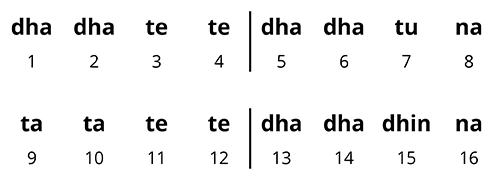
Speak this kayda to yourself and notice the similarity between the first 8 beats and the second 8 beats.
When you hear it either spoken or performed, you can also hear the 4 divisions as a simple stress pattern: “stressed-stressed-unstressed-stressed”, or as a simple melody: “down-down-up-down”.
Listen as Rajneesh speaks and then performs this kayda (2 times each):
This basic structure, and its many variations, is found in every tintal kayda, as well as in other classical forms.
The Stress Pattern of Tintal Kaydas
To understand a kayda’s stress pattern, you should understand the basic structure of tal, including its vibhags (divisions), and how all vibhags are either tali or khali (stressed or unstressed).
With that in mind, here is the basic structure of tintal:
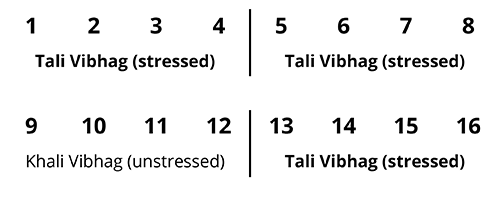
Tintal kaydas create this same stress pattern (or a similar pattern) with its open and closed baya bols (bass drum strokes):
- Tali sections (stressed) will have at least some open baya bols.
- Khali sections (unstressed) will have closed baya bols (or no baya bols).
In our beginner’s kayda, the bols with an open baya are in bold. Notice the overall pattern of stressed-stressed-unstressed-stressed in the 4 vibhags:
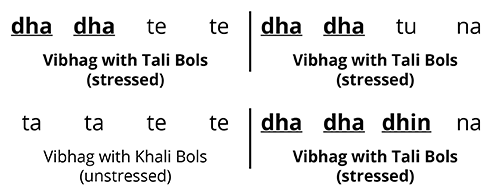
Listen again to this kayda and watch how it is played. Notice how the third vibhag has a closed baya throughout, while the other three vibhags have at least some open baya bols:
Now listen to a Dilli kayda in tintal. The phrases are more complex, but it has the same basic stress pattern of tali and khali bols:
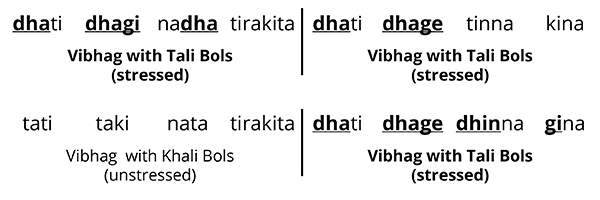
No matter how long or complex the kayda, you will see this same general stress pattern in all tintal kaydas.
The Parallel Halves of a Kayda
Above I mentioned that all kaydas are divided into two parallel halves which are similar, but different. More precisely, the two halves of a kayda are the same composition played in two different ways.
The difference between the two halves is the baya pattern (open or closed bass drum) for certain strokes which we can call tali-khali counterparts: the tali version has an open baya, and the khali version has a closed baya, or no baya.
Looking again at our beginner’s kayda, the tali-khali counterparts are connected by an arrow:

Watch again how this is played. Notice that the strokes on the daya (smaller drum) are the same for each half. Only the baya pattern changes (open or closed):
The Main Bol
So the two different versions are both based on the "main composition", or what tabla players sometimes call the "main bol".
“Main bol” in this sense is the fully open (tali) version, or what we can call the "parent composition":
- dhadha tete dhadha dhinna
Each half is then a different version of the parent (bols in italics change from parent):
- dhadha tete dhadha tuna
- tata tete dhadha dhinna
Notice that the parent composition above is not played fully open in the theme, though it may be in variations.
For another example, we can look at the Dilli kayda theme that we saw above. The tali-khali counterparts are connected by arrows:

Watch this kayda again and notice that the daya strokes are the same for each half; only the baya pattern changes:
In this kayda, the fully open parent composition is:
- dhati dhagi nadha tirakita, dhatidhage dhinna gina
And from this we make two versions for each half:
- dhati dhagi nadha tirakita, dhatidhage tinna kina
- tati taki nata tirakita, dhatidhage dhinna gina
This can be a little confusing when you are new to kaydas. But all tintal kaydas have these tali-khali counterparts. Eventually you’ll start to recognize them. (See the section on tali-khali counterparts for more guidance.
The Length of Kaydas
Above I wrote that a tintal kayda will be 16 matras (beats) in length "at some speed". But in performance, a kayda theme or variation is not always 16 matras in length; It depends on how fast it is performed in relation to the matra.
For example, a player might start in 2x speed, and then move to 4x speed. Or he might start in 4x speed, and then move to 8x speed.
To see how a kayda’s length can change in relation to the tal, let’s look again at our beginner’s kayda in tintal. At 1x speed, this kayda is 16 beats long and fits evenly in one round of tintal:

But when it is played at 2x speed it lasts only eight beats, and must be played twice to complete one round of tintal:
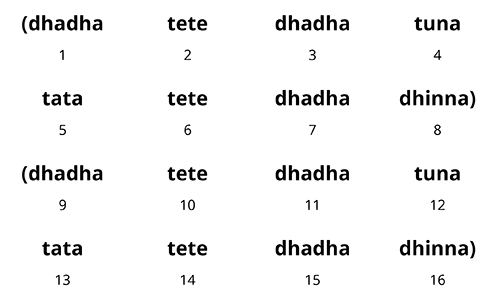
And at 4x, the theme will repeat 4 times inside of one round:

Watch this kayda’s theme played at the 4 speeds shown above:
So at some speed all kaydas will fit perfectly in the tal. But you may never hear that speed in performance. In this sense, there is no “real” or “original” length of a kayda.
This is important to understand: a kayda’s structure does not always align with the structure of the tal, but it always reflects it.
Conclusion
This basic structure of the tintal kayda is foundational to classical tabla. Learning to recognize this structure, and to identify tali-khali counterparts, will help you understand many other forms, including the rela, bant, pehskar, and gat-kayda.
This same structure can also be found in some cadential forms, such as the gat and fard. (See the Compositions section for examples.)
In the next section, we will look more closely at the phrases of a kayda theme, and how they help to further define the cyclic structure we saw above.
References
Misra, Chhote Lal. Tal Prabandh. New Delhi: Kanishka Publishers, 2006. (Hindi)
Naimpalli, Sadanand. Tabla for Advanced Students. Mumbai: Popular Prakashan Pvt. Ltd., 2009.